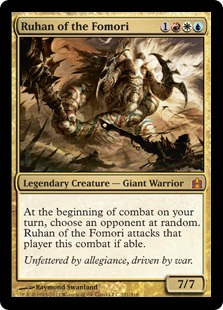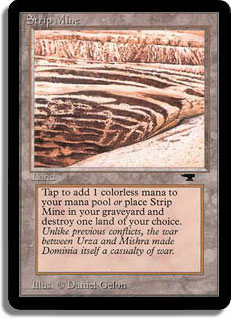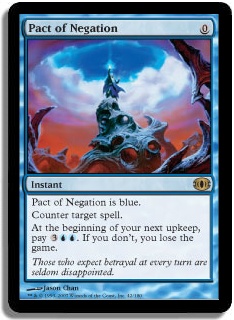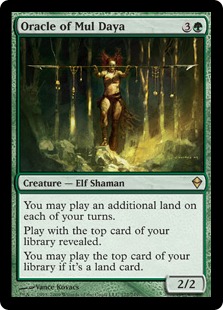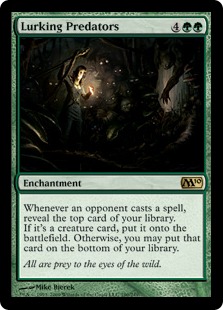While it’s fun to put together a Commander deck, it can be challenging as well. Not only do you have a huge pool of cards to build from, but some of the cards can be expensive to acquire (I’m looking at you, dual lands!). While Commander is really intended to be a multiplayer format, I’ve seen a ton of people playing one-on-one games between tournament rounds. If you’re going through all the trouble of getting a Commander deck together, wouldn’t it be great if it was effective in big group games AND those one-on-one duels when you’re just waiting for the next round to begin?
I’m here to tell you how you can make that happen.
But first, what makes a Commander deck “effective?” There are two parts to this: a deck has to be fun to play and have a decent chance of winning.
It may seem odd that this needs to be said, but I, for one, sometimes pay little to no attention to whether a deck is fun when I’m building for a tournament. I certainly don’t worry about whether or not my deck is fun for my opponent. Whether I lock you out of doing anything or just counter all your spells, it’s of no concern to me. I generally just play what I think will give me the best chance to win. If it’s a tie, I might play the deck that is more fun.
I feel differently about Commander.
Winning still gives me a warm, fuzzy feeling, but there’s really nothing on the line, so I tend to gravitate towards decks that do cool things even if they are not the absolute best decks I could be building. However, winning is always one good metric with which to measure your deckbuilding success. Let’s not just do cool things; let’s do cool things and WIN! That’s the best way I know to make the cool things even cooler.
Fun is kind of a subjective thing, so I take a selfish approach. I build for me. Sure, you get the occasional opponent who will sob, “Every time you build a fun deck, it’s only fun for you!” (it’s Orcish Spy and Millstone, get over it!), but it is really hard to tell what other people will find enjoyable. I play Magic a lot with my spouse, Jamie, and we both like drawn out counter wars, but there are some people who hate counterspells (I know! It’s hard to believe!).
I can’t really tell you what’s fun or cool (although I am going to share enough of my thoughts, strategies, and decklists that you’ll be brimming with ideas by the end of this). I can, however, tell you what wins.
Before I do that, let’s talk about the differences between one-on-one and group play.
One-On-One vs. Group Play
#1: Politics
That people are swayed by incentives should be no surprise (have you ever heard of Freakonomics?), but in duels versus group play, the incentives are different. In a duel, your opponent is going to attack you whether or not you have some combo in your deck or threaten to kill their creature, but in multiplayer, you may be able to talk your way out of unfortunate things happening to you.
This is all obvious, but I think one point, in particular, bears mentioning: you don’t have to play a political deck to be political!
Sure, there are decks that can play up this specific aspect of group play. Ruhan of the Fomori has a pseudo-political side. You can attack your opponents and claim that it wasn’t really your fault! Sure, your opponents may not buy that, but I’ve seen players use randomness itself as a political tool. “Let’s see, I have to attack someone…but I don’t want anyone to think I’m singling them out. Oh well, I’ll just let the dice decide!”
You can do that kind of thing regardless of what cards you’re playing with, but that only works in group play. In one-on-one play, the only way to incentivize your opponent not to do something to you is by putting fear into them, either with the cards you’re showing or the cards they’re worried might still be lurking in your deck or hand. A classic example is when they don’t play a spell because they’re afraid you’ll counter it.
#2: Threat and Answer Density
I once played a multiplayer with a guy who couldn’t understand why his creatures kept dying. He’d fill up his board, only to find it empty before it even reached his turn again. The reason was simple: he was the only person playing creatures, but he had to deal with the removal of several other players.
I almost always run Strip Mine, Wasteland, and Tectonic Edge in my Commander decks. I’m not looking to mana screw anyone. In a multiplayer game, that would be almost impossible, and you would have to really dedicate all of your land destruction resources against the same player to even have a chance of making this happen. No, I run a small land destruction package in most of my decks because there are some nasty lands played in Commander.
I tend to destroy Maze of Iths the most, but a fair number of Volrath’s Strongholds, Spinerock Knolls, and Mosswort Bridges have suffered that fate, along with a ton of other random lands that tend to show up at the worst possible times.
That’s the way things usually play out in multiplayer, but in one-on-one games, you can sometimes easily build up a high density of a certain type of card.
Many of my duels become land destruction fights, where combos like Life from the Loam and Strip Mine can single handedly win a game or just having enough Wasteland, Acidic Slime, Cryptic Command, Capsize, Decimate, Primal Command type cards along with Fork and Regrowth effects can effectively stop your opponent from doing anything.
Often you would use a lot of these cards for something other than getting rid of your opponents’ land if you are playing multiplayer, but it’s not hard to draw a lot of them in one-on-one games and go full-on land destruction.
The same principle applies to things like countermagic, which is generally bad in multiplayer except for stopping the game-breaking “I win” cards, but you can afford to use in a more cavalier way in duels.
#3: Small Advantages
In multiplayer, even a big advantage can be taken away if enough players attack you, but in one-on-one Commander, even small advantages can build into an avalanche much the way they would in any other format, making it really hard for the player on the other end to come back. It’s not just about torturing your opponent with the Death of a Thousand Strip Mines; even a single Strip Mine can push you quite a bit ahead if you use it to take out one of their Ravnica bounce lands, for example.
This is a complete aside, but I highly recommend playing the appropriate color bounce lands in every Commander deck, despite their vulnerability to land destruction. They won’t disrupt your tempo very much, if at all, and they are an easy two-for-one. Not to mention, they can reset your Bojuka Bogs and Spinerock Knolls as well as let you cycle the Secluded Steppe or Tranquil Thicket you needed to play early. They can let you choose a new target with Vesuva, and they can make cards like Snap and Treachery into a Dark Ritual.
Just be more cautious playing them in one-on-one. Most Commander decks should also have Strip Mine and Wasteland, and you don’t want to fall too far behind if your opponent happens to have one.
Multiplayer games tend to be won by something big and stupid. That’s why I’ve always felt zero guilt about using my Deceiver Exarch + Kiki, Jiki-Mirror Breaker combo. It’s one big, dumb combo amid a sea of big, dumb combos. Ironically, I can pull off the combo a lot easier in multiplayer than I can in one-on-one because of the ability to sneak it out when players are distracted by someone else!
#4: Game Length
More players don’t just make turns take longer, they also make games go more turns, so you can build up more mana in multiplayer and afford to try bigger things. Since each turn accounts for a smaller overall percentage of your game and your opponents can be distracted by other players, you don’t lose as much if you “waste” a turn. For example, you try a big spell that gets countered, you miss a land drop and don’t play anything, or you just choose to do nothing to see how the game develops. Obviously, in one-on-one, you won’t have this luxury.
So those are just a few differences between one-on-one duels and multiplayer games. I want to talk a little bit now about what types of cards are good and bad in multiplayer specifically.
What’s Good and Bad in Multiplayer
#1: Counterspells
Generally, these are not as good as in one-on-one because you only have so much mana and cards in your hand on a given turn and typically it won’t be enough to fight several other players. However, some of the worst game-breaking multiplayer cards can only be stopped with counterspells, so I gravitate toward two types: counterspells that are a two (or more) for ones, like Spelljack, Cryptic Command, and Desertion and counterspells that are free (to not auto-lose to a game-winning spell just because I’m tapped out) such as Force of Will or Pact of Negation. You don’t need a lot of counterspells; I usually run around 4-6 in my blue Commander decks, depending on what I’m trying to do and how much room there is in the deck.
#2: Creature Removal
Sweepers rule the day. Wrath of God, Pernicious Deed, Damnation, Hallowed Burial, Black Sun’s Zenith, Phyrexian Rebirth, Final Judgment, Savage Twister, Evacuation, and Rout are just a very small number of what’s out there. However, one-on-one answers have their place. They’re generally cheaper, for one thing. Plus, many of the best ones remove creatures from the game, like Swords to Plowshares and Path to Exile. A lot of them are also instants.
The problem with sweepers is that, even though you can take out your opponents’ full boards of creatures, it’s possible they might not have even attacked you! This means that some of your opponents will be at an effectively higher life total or might get to conserve cards they would’ve otherwise used to defend themselves.
Instant speed removal gives you a chance to defend yourself if something comes your way while giving opponents the chance to fight amongst themselves if they want. Not to mention that it can stop certain creatures before they get out of hand—like the aforementioned Kiki-Jiki!
So the short answer is that I advocate a mix of one-for-one instant speed removal and board sweepers in every deck.
#3: Mana Acceleration
If multiplayer is about playing big spells, then you certainly want to play big spells as soon as possible. Sol Ring goes in every deck, and you have nigh infinite possibilities if you’re in green: Explore, Rampant Growth, Sakura-Tribe Elder, Farseek, Exploration, Oracle of Mul Daya, Primeval Titan, etc.
I tend to stay away from acceleration that costs more than two with the exception of Oracle and Primeval Titan, which are just awesome creatures that have to be dealt with. A lot of people like Skyshroud Claim and its counterpart, Ranger’s Path; they are two-for-ones that can get Revised duals or Ravnica shock lands. I just like my ramp to be even cheaper, especially for those times where you just want a shuffle like when you have an active Oracle, a Future Sight, or a Sensei’s Divining Top in play.
If you’re not into green, there are many good artifact choices: Signets, Everflowing Chalice, Mind Stone, Fellwar Stone, Mana Vault, Grim Monolith, Talismans, and so on. The only thing I’d caution you on is to look out for artifact sweepers. They can set you very far behind if you’re not careful.
#4: Engines
I’ve already mentioned Future Sight, which is one of the best examples I know. You’re not “drawing” cards, but you’re getting as many cards a turn as you can play. With shuffle effects like fetchlands and ramp spells, that can turn out to be quite a lot. If you also have a Sensei’s Divining Top in play, you can convert every mana you have into an extra card in hand. Just draw a card with Top then recast the Top from the top of your deck with Future Sight.
Life from the Loam also qualifies. With cycling lands, you can get a three-for-one with every draw, providing you have enough mana.
Primeval Titan and Oracle aren’t just ramp spells, they’re creatures that will run the game if left unchecked.
Necropotence is legal in Commander also, so if you’re looking for a nostalgic good time with The Skull, go right ahead!
There’s a ton of engines I could list: card draw engines (the aforementioned Necropotence and Future Sight for example), recursion engines (Sword of Light and Shadow, Sun Titan), mana engines (Sword of Feast and Famine, Mirari’s Wake), card rebuying engines (Crystal Shard, Capsize), and ones that break the game in even more unusual ways (Lurking Predators).
The important thing is that you are doing big things. My multiplayer rule of thumb is “Go big or go home.” If you have to deal with multiple other players, you need ways to generate more cards and more mana. My best decks never run out of things to do.
Speaking of my “best decks,” here are a few!
Intet, the Dreamer
Creatures (21)
- 1 Sakura-Tribe Elder
- 1 Solemn Simulacrum
- 1 Kiki-Jiki, Mirror Breaker
- 1 Genesis
- 1 Anger
- 1 Eternal Witness
- 1 Mystic Snake
- 1 Duplicant
- 1 Draining Whelk
- 1 Body Double
- 1 Detritivore
- 1 Intet, the Dreamer
- 1 Mulldrifter
- 1 Glen Elendra Archmage
- 1 Nucklavee
- 1 Acidic Slime
- 1 Oracle of Mul Daya
- 1 Primeval Titan
- 1 Phyrexian Metamorph
- 1 Deceiver Exarch
- 1 Snapcaster Mage
Lands (37)
- 1 Strip Mine
- 4 Forest
- 1 Wooded Foothills
- 1 Wasteland
- 1 Karplusan Forest
- 2 Mountain
- 5 Island
- 1 Volcanic Island
- 1 Tropical Island
- 1 Taiga
- 1 Maze of Ith
- 1 Tranquil Thicket
- 1 Lonely Sandbar
- 1 Forgotten Cave
- 1 Yavimaya Coast
- 1 Shivan Reef
- 1 Gruul Turf
- 1 Izzet Boilerworks
- 1 Steam Vents
- 1 Stomping Ground
- 1 Breeding Pool
- 1 Simic Growth Chamber
- 1 Vesuva
- 1 Mosswort Bridge
- 1 Spinerock Knoll
- 1 Misty Rainforest
- 1 Scalding Tarn
- 1 Tectonic Edge
- 1 Command Tower
Spells (42)
- 1 Sensei's Divining Top
- 1 Brainstorm
- 1 Treachery
- 1 Tooth and Nail
- 1 Exploration
- 1 Force of Will
- 1 Wheel of Fortune
- 1 Sol Ring
- 1 Regrowth
- 1 Fellwar Stone
- 1 Wildfire
- 1 Impulse
- 1 Capsize
- 1 Rampant Growth
- 1 Land Grant
- 1 Decimate
- 1 Starstorm
- 1 Future Sight
- 1 Desertion
- 1 Evacuation
- 1 Savage Twister
- 1 Survival of the Fittest
- 1 Snap
- 1 Hull Breach
- 1 Guided Passage
- 1 Repulse
- 1 Fact or Fiction
- 1 Spelljack
- 1 Compulsive Research
- 1 Farseek
- 1 Life from the Loam
- 1 Izzet Signet
- 1 Simic Signet
- 1 Careful Consideration
- 1 Search for Tomorrow
- 1 Pact of Negation
- 1 Cryptic Command
- 1 Ponder
- 1 Primal Command
- 1 Explore
- 1 Preordain
- 1 Destructive Force

How It Works
You start out the early turns with mana acceleration, then you try to set up one of your engines: Life from the Loam, Oracle of Mul Daya, Future Sight, Primeval Titan, Nucklavee + Snap, Kiki-Jiki + Eternal Witness, Genesis, etc. Failing that, try to play a control game and bide your time.
Try not to expose Kiki to exile effects unless you have to. Wait to play Intet until you can protect it or at least give it haste. The land destruction element is mostly to stop Maze of Ith so you can hit with Intet, but you can also Wildfire and Destructive Force opponents right out of the game. Being ganged up on is no problem if your opponents have no land!
Generally, you will have more mana than your opponents and refilling your hand is cheap and easy. About 90% of the time, I win with Deceiver Exarch + Kiki. The other 10% are ground out with Intet, card advantage, and recursion.
Other Possibilities
The deck can easily be modified to include an extra turns theme. You don’t know joy until you’ve Time Stretched with Intet’s ability! You could also play with the top of your deck more with cards like Galvanoth, or you could take out some of the control elements and the “cute” cards like Snap and run more creatures, especially if you want to run a build that can effectively use Lurking Predators. I would suggest Woodfall Primus, Terastodon, Sphinx of Uthuun, and other creatures with great enters the battlefield abilities. Creatures die a lot in multiplayer, but you’ll still extract value out of them this way.
Sharuum the Hegemon
Creatures (15)
- 1 Solemn Simulacrum
- 1 Duplicant
- 1 Trinket Mage
- 1 Angel of Despair
- 1 Draining Whelk
- 1 Teferi, Mage of Zhalfir
- 1 Aeon Chronicler
- 1 Archon of Justice
- 1 Glen Elendra Archmage
- 1 Sharuum the Hegemon
- 1 Magister Sphinx
- 1 Stoneforge Mystic
- 1 Sun Titan
- 1 Phyrexian Metamorph
- 1 Snapcaster Mage
Planeswalkers (2)
Lands (37)
- 1 Strip Mine
- 3 Plains
- 1 Wasteland
- 1 Underground River
- 1 Adarkar Wastes
- 4 Island
- 1 Underground Sea
- 1 Tundra
- 1 Scrubland
- 1 Polluted Delta
- 1 Flooded Strand
- 1 Vault of Whispers
- 1 Seat of the Synod
- 1 Ancient Den
- 1 Secluded Steppe
- 1 Lonely Sandbar
- 1 Barren Moor
- 1 Caves of Koilos
- 1 Darksteel Citadel
- 1 Dimir Aqueduct
- 1 Watery Grave
- 1 Godless Shrine
- 1 Orzhov Basilica
- 1 Azorius Chancery
- 1 Hallowed Fountain
- 1 Urborg, Tomb of Yawgmoth
- 1 Sunken Ruins
- 1 Arcane Sanctum
- 1 Marsh Flats
- 1 Bojuka Bog
- 1 Tectonic Edge
- 1 Command Tower
Spells (46)
- 1 Sensei's Divining Top
- 1 Brainstorm
- 1 Wrath of God
- 1 Treachery
- 1 Yawgmoth's Will
- 1 Force of Will
- 1 Swords to Plowshares
- 1 Necropotence
- 1 Sol Ring
- 1 Demonic Tutor
- 1 Fellwar Stone
- 1 Necromancy
- 1 Darksteel Ingot
- 1 Future Sight
- 1 Beacon of Unrest
- 1 Sword of Light and Shadow
- 1 Death Grasp
- 1 Thirst for Knowledge
- 1 Phyrexian Arena
- 1 Vindicate
- 1 Rout
- 1 Fact or Fiction
- 1 Dismantling Blow
- 1 Compulsive Research
- 1 Dimir Signet
- 1 Orzhov Signet
- 1 Azorius Signet
- 1 Condemn
- 1 Damnation
- 1 Pact of Negation
- 1 Slaughter Pact
- 1 Cryptic Command
- 1 Ponder
- 1 Dispeller's Capsule
- 1 Courier's Capsule
- 1 Executioner's Capsule
- 1 Martial Coup
- 1 Path to Exile
- 1 Consuming Vapors
- 1 Elixir of Immortality
- 1 Brittle Effigy
- 1 Preordain
- 1 Nihil Spellbomb
- 1 Phyrexian Rebirth
- 1 Sword of Feast and Famine
- 1 Praetor's Grasp

How It Works
I call this deck “Sphinx-Blade” because it conjures up fond memories of hitting people with Sword of Feast and Famine. That is basically your goal in life with all your Tutoring effects, plus you have Sharuum and Sun Titan to get the Sword back if it’s destroyed. If someone exiles it you get sad…but plans like Sharuum + Magister Sphinx might still get you there. As long as you are connecting with the Sword, you will have absurd amounts of mana to do big things. Usually you don’t lose from that point.
Other Possibilities
You can run Sculpting Steel and Disciple of the Vault for some combo potential with Sharuum or go a heavy-handed control route, playing mostly instant speed cards and Mirari. This deck is more of a tap out style of control—it doesn’t have a lot of counterspells. However, if you’re way ahead with a Sword, make sure to protect your lead (especially from the dreaded artifact sweepers like Austere Command and Akroma’s Vengeance)!
Now for my baby:
The Mimeoplasm
Creatures (26)
- 1 Sakura-Tribe Elder
- 1 Solemn Simulacrum
- 1 Genesis
- 1 Eternal Witness
- 1 Mystic Snake
- 1 Duplicant
- 1 Draining Whelk
- 1 Body Double
- 1 Shriekmaw
- 1 Puppeteer Clique
- 1 Woodfall Primus
- 1 Glen Elendra Archmage
- 1 Acidic Slime
- 1 Oracle of Mul Daya
- 1 Avenger of Zendikar
- 1 Terastodon
- 1 Primeval Titan
- 1 Sheoldred, Whispering One
- 1 Phyrexian Metamorph
- 1 Jin-Gitaxias, Core Augur
- 1 The Mimeoplasm
- 1 Phantasmal Image
- 1 Sphinx of Uthuun
- 1 Snapcaster Mage
- 1 Evil Twin
- 1 Deadeye Navigator
Lands (37)
- 1 Strip Mine
- 3 Forest
- 1 Wooded Foothills
- 1 Wasteland
- 1 Volrath's Stronghold
- 2 Swamp
- 4 Island
- 1 Underground Sea
- 1 Tropical Island
- 1 Bayou
- 1 Windswept Heath
- 1 Polluted Delta
- 1 Flooded Strand
- 1 Bloodstained Mire
- 1 Tranquil Thicket
- 1 Lonely Sandbar
- 1 Barren Moor
- 1 Dimir Aqueduct
- 1 Golgari Rot Farm
- 1 Overgrown Tomb
- 1 Watery Grave
- 1 Breeding Pool
- 1 Simic Growth Chamber
- 1 Urborg, Tomb of Yawgmoth
- 1 Dryad Arbor
- 1 Mosswort Bridge
- 1 Marsh Flats
- 1 Misty Rainforest
- 1 Scalding Tarn
- 1 Verdant Catacombs
- 1 Command Tower
Spells (37)
- 1 Sensei's Divining Top
- 1 Brainstorm
- 1 Hinder
- 1 Exploration
- 1 Force of Will
- 1 Sol Ring
- 1 Regrowth
- 1 Demonic Tutor
- 1 Necromancy
- 1 Rampant Growth
- 1 Future Sight
- 1 Desertion
- 1 Bribery
- 1 Survival of the Fittest
- 1 Fact or Fiction
- 1 Spelljack
- 1 Compulsive Research
- 1 Farseek
- 1 Life from the Loam
- 1 Putrefy
- 1 Careful Consideration
- 1 Search for Tomorrow
- 1 Damnation
- 1 Pact of Negation
- 1 Slaughter Pact
- 1 Cryptic Command
- 1 Ponder
- 1 Primal Command
- 1 Lurking Predators
- 1 Explore
- 1 Consuming Vapors
- 1 Preordain
- 1 Green Sun's Zenith
- 1 Sword of Feast and Famine
- 1 Praetor's Grasp
- 1 Life's Finale
- 1 Spell Crumple

How It Works
The early game is similar to my Intet deck: you ramp, you play big spells, or you hold back and play control if you have to. Oracle and Primeval Titan are just as key in this deck creature-wise, and you have more creatures that can copy other creatures for extra Titan loving. Cast Bribery on a green deck if you can just to get the Titan shenanigans going sooner.
 (As an aside on Bribery, I didn’t test it in the other two decks, but that was an error on my part. Clearly, it should go in every blue Commander deck…).
The enters the battlefield effects are maximized for extra value every time The Mimeoplasm enters the battlefield, not to mention the dreaded Lurking Predators. Once Lurking Predators is in play, you usually can’t help but win. There are so many ways of hitting, from putting creatures on top of your deck with Brainstorm or Volrath’s Stronghold to activating Top. Or you can just play the odds. This deck is very creature dense, after all (compared to what I usually play!)
This deck also borrows some strategy from my Sharuum deck and runs Sword of Feast and Famine. It is harder to find in this deck but every bit as good when you do.
What makes this deck so scary is that once you get one scary card online, the scary cards quickly multiply. A turn around the table with Lurking Predators and you could easily end up with a full board.
Usually you’ll win in just that way, with about twenty nasty creatures staring down your opponents, sometimes locking them out of the game (multiple Glen Elendras + Sheoldred for example or Jin-Gitaxias). Alternatively, just one Avenger of Zendikar will do it sometimes. I’ve generated up to 70 power from Plants before!
One thing that makes this deck different than the other two is the full complement of fetches. I didn’t own shocklands or duals for my early Commander decks and got in the habit of just playing on-color fetches. However, if you have the duals, each fetch can potentially get you all three colors of mana (and I notoriously love the tri-color decks the most!), not to mention they work wonders with Oracle, Future Sight, Top, or Life from the Loam. You can even find Dryad Arbor at instant speed for a surprise blocker or Sword-bearer!
Other Possibilities
With The Mimeoplasm, Putrefax or Skithiryx, the Blight Dragon and any big creature can instantly poison a player out of the game. Triskelion and Mikaeus, the Unhallowed are an infinite damage combo that is much easier to pull off with a Commander who can come in as one of those if they’re in your graveyard. I didn’t use either of these combos because the individual cards aren’t good enough on their own and I don’t think they’d be particularly easy to pull off in a multiplayer. But feel free to try!
Until next time, just remember these words: “Don’t attack me! I’m not a threat…”

